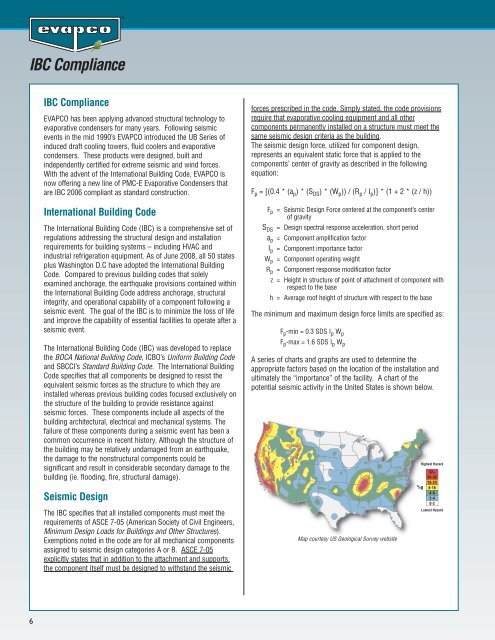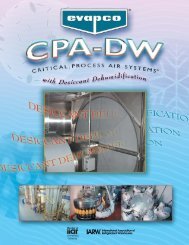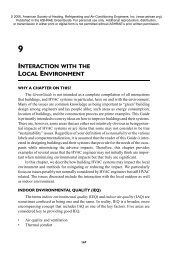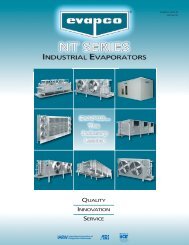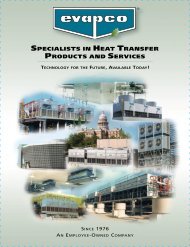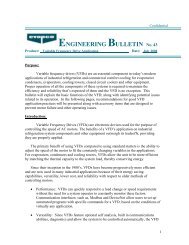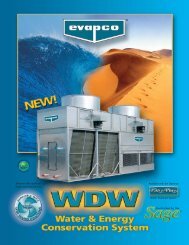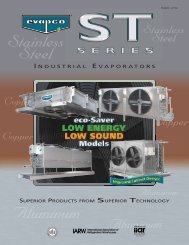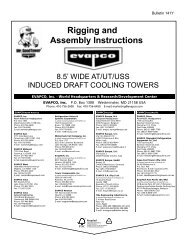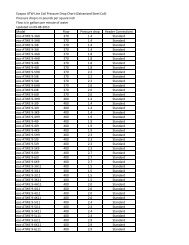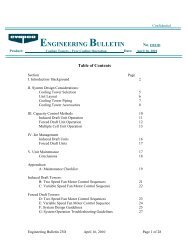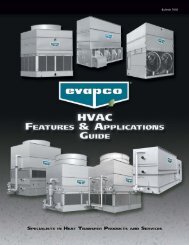PMC-E Product Brochure - EVAPCO.com
PMC-E Product Brochure - EVAPCO.com
PMC-E Product Brochure - EVAPCO.com
You also want an ePaper? Increase the reach of your titles
YUMPU automatically turns print PDFs into web optimized ePapers that Google loves.
IBC Compliance<br />
6<br />
IBC Compliance<br />
<strong>EVAPCO</strong> has been applying advanced structural technology to<br />
evaporative condensers for many years. Following seismic<br />
events in the mid 1990’s <strong>EVAPCO</strong> introduced the UB Series of<br />
induced draft cooling towers, fluid coolers and evaporative<br />
condensers. These products were designed, built and<br />
independently certified for extreme seismic and wind forces.<br />
With the advent of the International Building Code, <strong>EVAPCO</strong> is<br />
now offering a new line of <strong>PMC</strong>-E Evaporative Condensers that<br />
are IBC 2006 <strong>com</strong>pliant as standard construction.<br />
International Building Code<br />
The International Building Code (IBC) is a <strong>com</strong>prehensive set of<br />
regulations addressing the structural design and installation<br />
requirements for building systems – including HVAC and<br />
industrial refrigeration equipment. As of June 2008, all 50 states<br />
plus Washington D.C have adopted the International Building<br />
Code. Compared to previous building codes that solely<br />
examined anchorage, the earthquake provisions contained within<br />
the International Building Code address anchorage, structural<br />
integrity, and operational capability of a <strong>com</strong>ponent following a<br />
seismic event. The goal of the IBC is to minimize the loss of life<br />
and improve the capability of essential facilities to operate after a<br />
seismic event.<br />
The International Building Code (IBC) was developed to replace<br />
the BOCA National Building Code, ICBO’s Uniform Building Code<br />
and SBCCI’s Standard Building Code. The International Building<br />
Code specifies that all <strong>com</strong>ponents be designed to resist the<br />
equivalent seismic forces as the structure to which they are<br />
installed whereas previous building codes focused exclusively on<br />
the structure of the building to provide resistance against<br />
seismic forces. These <strong>com</strong>ponents include all aspects of the<br />
building architectural, electrical and mechanical systems. The<br />
failure of these <strong>com</strong>ponents during a seismic event has been a<br />
<strong>com</strong>mon occurrence in recent history. Although the structure of<br />
the building may be relatively undamaged from an earthquake,<br />
the damage to the nonstructural <strong>com</strong>ponents could be<br />
significant and result in considerable secondary damage to the<br />
building (ie. flooding, fire, structural damage).<br />
Seismic Design<br />
The IBC specifies that all installed <strong>com</strong>ponents must meet the<br />
requirements of ASCE 7-05 (American Society of Civil Engineers,<br />
Minimum Design Loads for Buildings and Other Structures).<br />
Exemptions noted in the code are for all mechanical <strong>com</strong>ponents<br />
assigned to seismic design categories A or B. ASCE 7-05<br />
explicitly states that in addition to the attachment and supports,<br />
the <strong>com</strong>ponent itself must be designed to withstand the seismic<br />
forces prescribed in the code. Simply stated, the code provisions<br />
require that evaporative cooling equipment and all other<br />
<strong>com</strong>ponents permanently installed on a structure must meet the<br />
same seismic design criteria as the building.<br />
The seismic design force, utilized for <strong>com</strong>ponent design,<br />
represents an equivalent static force that is applied to the<br />
<strong>com</strong>ponents’ center of gravity as described in the following<br />
equation:<br />
F p = [(0.4 * (a p) * (S DS) * (W p)) / (R p / I p)] * (1 + 2 * (z / h))<br />
Fp = Seismic Design Force centered at the <strong>com</strong>ponent’s center<br />
of gravity<br />
SDS = Design spectral response acceleration, short period<br />
ap = Component amplification factor<br />
Ip = Component importance factor<br />
Wp = Component operating weight<br />
Rp = Component response modification factor<br />
z = Height in structure of point of attachment of <strong>com</strong>ponent with<br />
respect to the base<br />
h = Average roof height of structure with respect to the base<br />
The minimum and maximum design force limits are specified as:<br />
Fp-min = 0.3 SDS Ip Wp Fp-max = 1.6 SDS Ip Wp A series of charts and graphs are used to determine the<br />
appropriate factors based on the location of the installation and<br />
ultimately the “importance” of the facility. A chart of the<br />
potential seismic activity in the United States is shown below.<br />
Map courtesy US Geological Survey website<br />
Highest Hazard<br />
32+<br />
24-32<br />
16-24<br />
%g 8-16<br />
4-8<br />
2-4<br />
0-2<br />
Lowest Hazard


